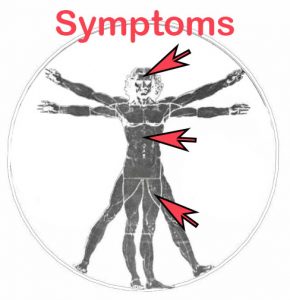 Illness starts with the symptoms. We notice the symptoms first. Something feels strange. Our bodies, our minds, our spirits – even our communities are always alert to possible danger. “Am I sick?“, we ask ourselves. Or is it normal? Life is complex. Are our feelings sensing danger? Or is everything A OK? We can only wait and see. Do they fade, or persist, or grow?
Illness starts with the symptoms. We notice the symptoms first. Something feels strange. Our bodies, our minds, our spirits – even our communities are always alert to possible danger. “Am I sick?“, we ask ourselves. Or is it normal? Life is complex. Are our feelings sensing danger? Or is everything A OK? We can only wait and see. Do they fade, or persist, or grow?
Our bodies are on constant alert to our internal status, and our mind is always monitoring our physical feelings. Are they symptoms of illness? Symptoms can be a sign of vibrant health. Spring fever. Young love. Growth. Success. They feel strange because they are infrequent or new. Sometimes, symptoms occur in clusters – when something new happens. But medicine views symptoms as perceptions of illness. When symptoms are severe, or lasting, or growing, we consult a doctor.
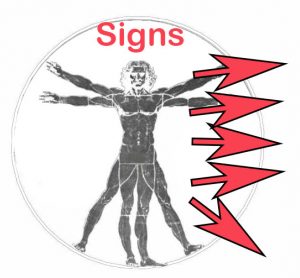 A doctor listens as we talk about our symptoms, for a few moments, and then proceeds to examine signs. Symptoms are the things we feel. Signs are things the doctor can see. There are thousands of signs that can be measured independent of our senses. If there is a possibility of danger, our vital signs are measured: respiration, pulse, temperature, and blood pressure. Each of these can be measured independently – even when we are near death. Pain, the fifth vital sign is measured by asking: “How much pain is there, on a scale of 1 to 10?” Signs are measured with numbers, not with feelings. Signs are measured by someone else, someone independent, perhaps even a machine. We might measure some signs ourselves, but the doctor or nurse will measure again, just to be sure.
A doctor listens as we talk about our symptoms, for a few moments, and then proceeds to examine signs. Symptoms are the things we feel. Signs are things the doctor can see. There are thousands of signs that can be measured independent of our senses. If there is a possibility of danger, our vital signs are measured: respiration, pulse, temperature, and blood pressure. Each of these can be measured independently – even when we are near death. Pain, the fifth vital sign is measured by asking: “How much pain is there, on a scale of 1 to 10?” Signs are measured with numbers, not with feelings. Signs are measured by someone else, someone independent, perhaps even a machine. We might measure some signs ourselves, but the doctor or nurse will measure again, just to be sure.
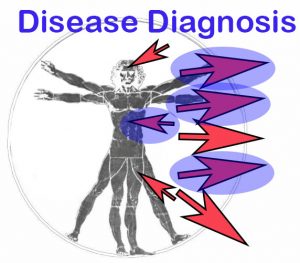 Diagnosis begins with signs and symptoms. “Diagnostic Criteria” are published symptoms and signs used by a physician to determine a diagnosis. Sometimes, it stops there especially for chronic diseases. Many diseases have diagnostic criteria consisting entirely of symptoms and signs, with no test for cause. This serious error leads directly to a failure to cure.
Diagnosis begins with signs and symptoms. “Diagnostic Criteria” are published symptoms and signs used by a physician to determine a diagnosis. Sometimes, it stops there especially for chronic diseases. Many diseases have diagnostic criteria consisting entirely of symptoms and signs, with no test for cause. This serious error leads directly to a failure to cure.
Diagnosis is the grouping of some signs and symptoms that indicate a specific disease. There are always many symptoms, many signs, and signs are on a scale. Diagnosis is an art. Typically, only a few signs and symptoms contribute to the diagnosis, although many might contribute to other ‘not diagnosed’ diseases.
Chronic Disease
A chronic disease is diagnosed if the illness persists for some time, and no cause can be identified. Chronic diseases are often defined as ‘incurable’. However, it is not possible to prove that any illness is incurable. When the cause is identified, and addressed, the illness can be cured. If there is no cause to be addressed – it’s not an active disease, it’s a handicap, or perhaps simply a physical attribute.
Chronic diseases proceed directly from diagnosis to treatment, not cure. Treatments for chronic disease consist of symptomicines. Symptoms are treated, there is no attempt to search for, much less address a cause, except perhaps in vague general guidelines, often given as “how to learn to live with your disease“. Painkillers, more painkillers, more powerful painkillers, more sophisticated painkillers. Treatments are designed to push symptoms below the threshold of annoyance, and if possible, below the threshold of diagnosis, without addressing any cause. The cause is often still present, pushing against the medicine. We shouldn’t wonder why most medicines have effects that burst thru the seams, side effects that get worse and worse the longer we take the medicine?
Cause
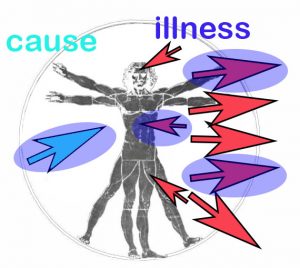 Every illness has a cause. For many illnesses, like the common cold, which are quickly and easily cured by health, knowing the present cause is not so important. Our health can effectively deal with the cause, we need only give it time. The more health we have – the faster the cure. The less health we have, the longer it takes. The less health we have, the more frequent colds. The cure for the common cold is healthiness, there is no ‘medical cure’, no external cure, that can work so fast and effectively.
Every illness has a cause. For many illnesses, like the common cold, which are quickly and easily cured by health, knowing the present cause is not so important. Our health can effectively deal with the cause, we need only give it time. The more health we have – the faster the cure. The less health we have, the longer it takes. The less health we have, the more frequent colds. The cure for the common cold is healthiness, there is no ‘medical cure’, no external cure, that can work so fast and effectively.
Causes of illness, even causes of chronic illness, are everywhere. We are surrounded by causes of illness, without suffering any symptoms, without becoming ill, just as we can have many signs and symptoms without being ill. We can inhale smoke, or consume poisons like alcohol, without illness, even for enjoyment, for the thrill they give our nervous system. This is normal and can even have healthy effects.
Our bodies, minds, spirits, and communities; our health – use cause and effect as a basic tool of life. The first living cell is defined not by the dead physical chemical components, but by its use of cause and effect to manage its life, to use its external environment to grow and reproduce. Cause and effect are the causes, and the consequences of life. Events happen, but only life causes events to happen, and judges events as having positive or negative effects. Life is goal directed, and cause and effect are defined based on life’s goals.
An illness only exists when a cause has a significant negative effect, significant negative consequences. Every illness has a cause. The treatment of every illness improves when we know and address a cause. Cures are only effective, only true cures, when they address the cause. Preventative actions are effective when they address future causes.
There are three types of causes. First, there is the absent cause. A broken arm, a gunshot wound, even a broken heart, can only be cured by healing. The cause is gone, but understanding it can be useful to develop preventative behaviors and actions. Second, are illnesses where the cause is present and active – like the bacterial infection. In these cases, the cure is to address the cause, which will allow healing to complete the cure process.
The third type of causes are chronic causes. Chronic causes are continually, chronically, repeated.
Chronic Causes
Chronic illnesses have chronic causes. Chronic illnesses wax and wane, grow and shrink, attack and fade away, as time passes. Our bodies are always working to heal damage that results from illness, from causes. If the cause moves away, or lessens, healing gains ground and health recovers. When the cause returns more damage occurs.
Sometimes, the lag between cause and symptoms, and between damage and healing can be very long, making it very difficult to be certain of the cause. Often, both the cause and the healing are active, creating a see-saw of symptoms and relief that can last days, weeks, months or even years. The cause can only be proven by the cure.
Illness
An illness only exists when cause and negative consequences are linked. When a cause is severe enough to result in negative and serious, or dangerous consequences.
A disease, on the other hand, can only exist when an illness is common enough to have a diagnostic criteria, and severe enough in a specific instance to be diagnosed. It is important to distinguish between illness and disease. An illness is what the patient has. An illness must be present, and may have been present for a very long time, before a disease is diagnosed. It is possible to have an illness without a diagnosis, without a disease. A disease is what the doctor diagnoses, correctly or incorrectly. Diagnosis is an art – sometimes art produces garbage.
A simple illness, like a hangover, has a simple cause – drinking too much alcohol, in too short a time. Even such a simple illness can have a long chain of ’causes’ that might be used for prevention. We can always ask “what is the cause of the cause“. Maybe we shouldn’t have gone to the party. Maybe the drinks were made too strong. Maybe not enough water was consumed. Maybe if the party had ended earlier, we wouldn’t have a hangover. These are sometimes just excuses, not useful causes. They are only useful causes when we actually use them to prevent or cure the illness.
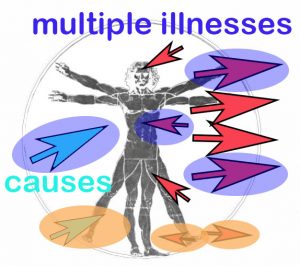 Most simple illnesses, like a hangover, are cured by health and by time. Our liver filters out the toxic alcohol. Our bodies will naturally seek water, to treat the dehydration. Our brains seek quiet rest, to facilitate physical recovery. Healthier bodies, minds, spirits, and communities cure hangovers faster. Less healthy bodies, minds, spirits and communities cure slowly, and are more likely to spiral downwards, perhaps even attempting to cure with “the hair of the dog”, creating a chronic illness.
Most simple illnesses, like a hangover, are cured by health and by time. Our liver filters out the toxic alcohol. Our bodies will naturally seek water, to treat the dehydration. Our brains seek quiet rest, to facilitate physical recovery. Healthier bodies, minds, spirits, and communities cure hangovers faster. Less healthy bodies, minds, spirits and communities cure slowly, and are more likely to spiral downwards, perhaps even attempting to cure with “the hair of the dog”, creating a chronic illness.
It is, of course, possible to have many illnesses at one time. Someone might have a a cold, and ingrown toenail, and hangover, all at the same time. Each illness has a unique cause. Some might have overlapping signs and symptoms.
Multiple Illnesses
It’s also possible to have multiple illnesses with similar symptoms – with different causes. We might have a headache from a hangover, and fall down and get another headache from a bump on the head. The hangover headache will be cured in a few hours – the headaches from the fall might take longer.
Is anyone ever diagnosed with two illnesses at once, with the same symptoms? It’s a very rare occurrence (the diagnosis, not the event). The technique of diagnosis is specifically designed to find a single illness. That’s a strength of diagnosis and a weakness.
What if someone has two colds and a flu? The common cold can be caused by hundreds of different viruses. The flu is caused by different viruses. It is possible, perhaps even frequent, to be infected by a cold virus, and a flu virus at the same time. There are two causes – and two illnesses. The symptoms are similar, but not identical. It might be that having the flu makes colds more or less likely, or that having a cold makes the flu more or less likely – as far as I know this has not been studied.
Multiple Illness – One Disease
It is possible, for example, to have a bacterial infection that consists of several different types of bacteria, at the same site, at the same time, causing the same symptoms. The entire disease is a single infection. Several illness are present, caused by several different bacteria strains on the same site. Every illness can be cured. A single bacterial infection illness can be cured with a dose of an effective antibiotic.
A multiple illness, consisting of several bacterial infections is diagnosed as a single disease, infection. When treated with antibacterial medicine, it might appear to go into remission, because one type of bacteria, one of the bacterial illnesses, has been addressed. Then the disease appears to re-emerge when the second type of bacteria takes over. A second, different antibacterial medicine might be necessary to cure the second illness.
The disease model sees a single disease – infection, and two treatments resulting in a cures. The illness model sees two illnesses, each with independent cures, addressing independent causes.
Cure
Every active illness has an active cause. Every active illness has a cure. To cure is to address the cause, to break the link between cause and symptoms. There are two basic techniques to cure an illness
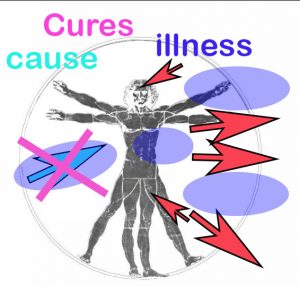 If the cause is the excess or deficiency of something – a nutrient, a toxic chemical, an excess of exercise, a deficiency of exercise, an excess or deficiency of mental stress, an excess or deficiency of spirits and feelings, even an excess or deficiency of community involvement – one cure is to address the excess, or the deficiency.
If the cause is the excess or deficiency of something – a nutrient, a toxic chemical, an excess of exercise, a deficiency of exercise, an excess or deficiency of mental stress, an excess or deficiency of spirits and feelings, even an excess or deficiency of community involvement – one cure is to address the excess, or the deficiency.
The other cure is to strengthen, to health the body, mind, spirits, or the community, such that it is able to handle the excess or deficiency, without illness. Healthier bodies get sick less often, and improving healthiness is an important cure for many illnesses. We might view every true cure as an improvement in healthiness.
These cures work when the cause is active. When the cause is no longer active – healing is the only cure. Often, complete healing is not possible, and what is left is a disability, not an illness.
Diseases with Multiple Causes
But… There are many diseases with more than one cause, aren’t there? Remember that many diseases – most especially chronic diseases, are diagnosed without any reference to cause. This fosters an illusion that there is no cause to be addressed, or that there are many causes.
There are two ways for a disease to have multiple causes.
Like illness, every disease can have a chain of causes. Finding a chain is simple once we identify a single cause. We simply ask “what is the cause of this cause?“, and then ask “What is the cause of the cause that caused this cause“, and so on… If it is a true chain, then breaking any link will cure the disease. In some cases, the key cause may have several ’cause causes’. He has a hangover because he drank too much. He drank too much because the booze was free, because there was no food, because he was lonely… In these cases, a preventative – a future cure – might be found in addressing specific causes of causes.
Sometimes a disease has independent causes, not linked in a chain. These indicate the presence of multiple illnesses.
Half a Disease
Is anyone ever been diagnosed with ‘half a disease’? Diagnostic techniques deliver Yes/No decisions. Although a disease might be diagnosed as mild, moderate, or severe, there is no diagnostic concept of ‘half of a disease’.
When a disease has exactly two independent causes, where each of the causes is sufficient to cause the symptoms, then addressing one cause will cure ‘half’ of the disease. When a disease is half-cured, what is left? The half that is left is still the disease.
An illness or a disease is a hole in your health. It is not a thing you can touch, like an apple, that – when you eat one half, half remains. A disease is like a hole in the ground. When you fill half of it – you still have a hole. But filling the first half is a necessary step to filling the hole.
Curing half a disease is often a necessary first step to cure a whole disease, even if diseases aren’t be measured in halves. A half a disease is a single illness, when a patient has two illnesses with one disease name. It is also possible, perhaps commonplace, to have 1/3 of a disease – a disease that consists of three illnesses with similar symptoms. A disease of this type might appear very difficult, even impossible to cure, because each illness cure only partially cures the disease, leading the patient and the doctor to give up. The disease might easily be labeled ‘chronic’ and ‘incurable’.
Chronic Illness
A chronic illness has a chronic cause. Every illness has a single cause. Every chronic illness has a single, chronic cause. Every illness is cured by addressing the cause. Every chronic illness is cured by addressing the chronic cause.
Nutrient deficiencies are chronic illnesses. Starvation is a chronic illness, with a chronic cause. We don’t often think of starvation as an illness, but of course it is, and for it to continue, it must be chronic.
Scurvy is a chronic illness, caused by a chronic deficiency of Vitamin C in the diet. We can treat scurvy with a medicine – capsules of synthetic or purified Vitamin C, but doing so simply extends the chronic nature of the illness. It does not address the dietary cause, and can not cure the illness, even though it might speed up healing. The patient will need to take medication, Vitamin C tablets, for the rest of their life, or until the diet changes, perhaps due to some other circumstances, and the illness is mysteriously ‘cured’. There will be side effects, because a diet that does not contain sufficient Vitamin C is also deficient in other nutrients. These effects, of the chronic treatment, can be more mysterious, taking longer to appear. The patient might also suffer gastric problems, because the medicine tablets are acidic.
Scurvy is a chronic illness – cured with a healthy diet. Every illness can be cured. Every chronic illness can be cured. Why are chronic illnesses defined as ‘incurable’ in our current medical paradigm? Because we give up too easily. Part of the problem is that symptomicines are so easy to buy, to produce, and so effective in the short term, that they giving the illusion of health.
Perhaps most chronic diseases are actually multiple chronic illnesses, each with single chronic causes. If disease the cause is simple, single, – we might easily find it ourselves, perhaps even without the assistance of a doctor.
Anyone with a chronic disease has lots of time to try different cure actions. We sometimes hear claims that someone cured their chronic disease. Sometimes we cure our disease with health, even chronic diseases. People who cure their chronic diseases are generally ignored, even shunned. In many cases, what actually caused the cure is anybody’s guess. Cures are seldom investigated. Even most clinical studies, measure symptoms and ignore cures, because cured is not part of the study definitions.
Take note: diseases are never cured by placebos. They are cured by healthy actions. Placebo effect is a label given my medical practitioners when they do not understand what happened, and are not interested in investigating. If the disease is gone, what’s to investigate? There are lots of sick patients to be attended to.
Because a chronic disease can consist of several chronic illnesses – it is possible to cure one or more of the illnesses without even being aware of it. As with the multiple infection illness – the first cure seems to provide relief, but then fails to ‘cure the disease’. Cure of the disease, is visible only when all of the component illnesses are cured.
Unfortunately, our medical systems do not make effective study of nor use of cures. Chronic diseases are ‘treated’, often without reference to cause. They are intentionally “not cured“, using symptomicines, medicines that address symptoms not cause, medicines that make no claim to cure. As a result, a simple chronic illness can easily grow, over time, to a complex chronic disease, consisting of multiple chronic illnesses. This can even happen before any disease is diagnosed.
Modern medicine can easily fail to cure chronic diseases, because chronic illnesses causes are part of the life, of the habits of the patient. These cannot be ‘cured’ with medicines. Alcoholism and obesity have, in theory, simple causes. But these theoretical causes are not sufficient to cure.
Cures must address the cause that is necessary and sufficient to cure. Not the cause that is necessary and sufficient to cause the illness. Not any cause that is only sufficient to blame.
If we want to cure these diseases, perhaps if we want to cure any chronic disease, it helps to ask some different, difficult questions. They begin with “what is the cause?” and “what are the causes of the cause?..“. But it is also important to ask “How is the patient benefiting from the cause?“, and “How is the patient benefiting from the cause of the cause?” And sometimes its important to ask “how might the patient be benefiting from the illness?”
These questions are difficult to ask, and can be more difficult to answer. It takes time and persistence to consider them fully in individual cases. They help us to recognize that we often deliberately choose the causes of our illness, or the causes of those causes. Sometimes we deliberately choose the illness.
Chronic Healthiness
The opposite of a chronic disease is often called a self-limiting disease. A chronic disease is one that lasts a long time. A self-limiting disease is one that lasts a short time, and is quickly cured by our health – like the common cold or hangover. Our medical systems search for disease, and for chronic disease.
We need to search for chronic healthiness. Chronic comes from the Greek word ‘kronos’, meaning time. We need to search for health that lasts a long time. How can we find it?
Symptomicines, medicines that address symptoms but not cause, provide temporary, self-limiting illusion of healthiness. The illness reasserts itself in time, because the cause was not addressed.
To find chronic healthiness, we need to search for causes, we need to search for cures that address causes. Many chronic illnesses are caused by chronic habits – that need to be replaced with healthy habits.
Healthy habits lead to chronic healthiness.
to your health, tracy


